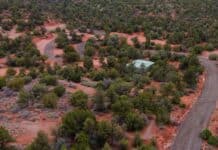My name is Brock Delinski and I’d like to tell you who I am and why I’ve decided to run for Sedona City Council. I’m not going to start by rambling on about my qualifications, awards and certificates held, because, let’s face it … who cares? Instead I’m going to start by telling you a brief story.
Like all Sedona stories, it starts in one direction and ends up in a completely different place.
| Editor’s Note |
| This part of a series of essays written by the candidates running for the Sedona City Council. The primary election is Tuesday, Aug. 28. |
I grew up in rural southern Michigan and never felt like I truly fit in. The snow, mentality and overall vibe never resonated with me. I wasn’t able to put my finger on it at the time, but I had a constant feeling that something was off.
It wasn’t until my first trip out West in 2005 that I was able to see the whole different world out there, waiting to be explored. I was mesmerized by the wide open spaces, the mountain ranges and the lifestyle of being surrounded by these magical places. When my corporate job offered a transfer to the facility in Phoenix, I jumped at the opportunity.
This was when my love affair with Sedona began. I would take monthly camping trips up to the Verde Valley and feel more connected to the area than I ever had to any other place.
In 2012, the woman of my dreams and I were married here in Sedona, while living and working in Chicago. For our honeymoon, we quit our corporate jobs, sold everything we owned, including two paid-off cars, and set off to see the world, indefinitely.
Our first adventure was a coast-to-coast bike ride across America. Five months and 4,600 miles later, we reached Astoria, Ore., with no intentions of stopping. We traveled internationally for the next year and fell in love with New Zealand, disliked Italy, summitted Mount Whitney and lived like locals in foreign lands.
During our travels, we changed our diets to eliminate sugar, meat and dairy. My wife also opened her coaching practice, while living out of a backpack. It soon became clear that growing a new business and relearning how to cook and eat was incredibly difficult while constantly on the move.

We decided to settle in Sedona for six months on a whim, to be stationary for a bit before moving on to somewhere else. That was 4 and a half years ago. We’ve since bought our dream home, rescued a doggie and kitty, opened two more businesses and completely fallen in love with living here.
I never thought I’d find a place I could truly call home. I’d always felt as if I wasn’t truly connected to the places that I had lived. Now my backyard is a place that most people in the world only dream of visiting, or have to use their vacation time to explore.
My love for Sedona created my desire for a sustainable future for the city, not just in terms of the environment, but also through development that meets the needs of the present, without compromising future generations’ choices. I believe we need careful planning to foresee problems before they arise, rather than wildly reacting once they rear their ugly heads.
I am an avid environmentalist and think we’re missing a huge opportunity in regards to ecotourism and environmental sustainability. Market trends, consumers and the general public are demanding changes to “business as usual.”
The European Union is working to ban plastic straws and Georgetown, Texas, is the first U.S. city to run completely on renewable energies. I believe we have a responsibility to step up and lead the charge to make a better future for our city.
We have the opportunity to make Sedona the greenest city in America. All the challenges that our city currently faces could be eliminated by looking at things through a more sustainable lens. Housing, traffic and tourist capacity can all be solved by adopting a more sustainable approach. Affordable, tiny house communities could help solve the housing crisis. Planning for an increase in traffic for the year 2050 could ensure that we solve the problem once and for all.
I want Sedona to start looking at governance in a completely different light. We’ve been in a state of reaction for too long already and I want to help usher in a new emphasis on the future. We need to take control of creating the change we want to see in our city and, ultimately, the world.
I grew up in rural southern Michigan and never felt like I truly fit in. The snow, mentality and overall vibe never resonated with me. I wasn’t able to put my finger on it at the time, but I had a constant feeling that something was off.
It wasn’t until my first trip out West in 2005 that I was able to see the whole different world out there, waiting to be explored. I was mesmerized by the wide open spaces, the mountain ranges and the lifestyle of being surrounded by these magical places. When my corporate job offered a transfer to the facility in Phoenix, I jumped at the opportunity.
This was when my love affair with Sedona began. I would take monthly camping trips up to the Verde Valley and feel more connected to the area than I ever had to any other place.
In 2012, the woman of my dreams and I were married here in Sedona, while living and working in Chicago. For our honeymoon, we quit our corporate jobs, sold everything we owned, including two paid-off cars, and set off to see the world, indefinitely.
Our first adventure was a coast-to-coast bike ride across America. Five months and 4,600 miles later, we reached Astoria, Ore., with no intentions of stopping. We traveled internationally for the next year and fell in love with New Zealand, disliked Italy, summitted Mount Whitney and lived like locals in foreign lands.
During our travels, we changed our diets to eliminate sugar, meat and dairy. My wife also opened her coaching practice, while living out of a backpack. It soon became clear that growing a new business and relearning how to cook and eat was incredibly difficult while constantly on the move.
We decided to settle in Sedona for six months on a whim, to be stationary for a bit before moving on to somewhere else. That was 4 and a half years ago. We’ve since bought our dream home, rescued a doggie and kitty, opened two more businesses and completely fallen in love with living here.
I never thought I’d find a place I could truly call home. I’d always felt as if I wasn’t truly connected to the places that I had lived. Now my backyard is a place that most people in the world only dream of visiting, or have to use their vacation time to explore.
My love for Sedona created my desire for a sustainable future for the city, not just in terms of the environment, but also through development that meets the needs of the present, without compromising future generations’ choices. I believe we need careful planning to foresee problems before they arise, rather than wildly reacting once they rear their ugly heads.
I am an avid environmentalist and think we’re missing a huge opportunity in regards to ecotourism and environmental sustainability. Market trends, consumers and the general public are demanding changes to “business as usual.”
The European Union is working to ban plastic straws and Georgetown, Texas, is the first U.S. city to run completely on renewable energies. I believe we have a responsibility to step up and lead the charge to make a better future for our city.
We have the opportunity to make Sedona the greenest city in America. All the challenges that our city currently faces could be eliminated by looking at things through a more sustainable lens. Housing, traffic and tourist capacity can all be solved by adopting a more sustainable approach. Affordable, tiny house communities could help solve the housing crisis. Planning for an increase in traffic for the year 2050 could ensure that we solve the problem once and for all.
I want Sedona to start looking at governance in a completely different light. We’ve been in a state of reaction for too long already and I want to help usher in a new emphasis on the future. We need to take control of creating the change we want to see in our city and, ultimately, the world.


















